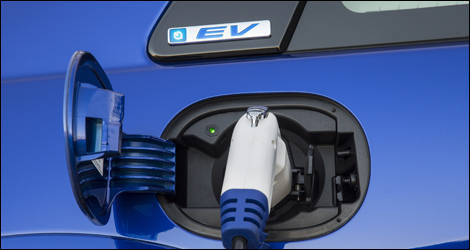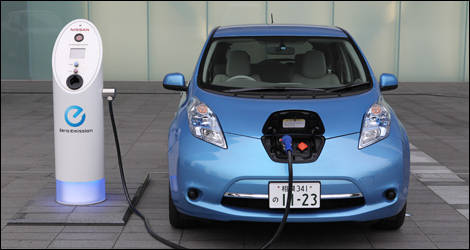Rarefying resources, difficult extraction processes, uncertain recycling; how much truth lies in the popular electric car myths? These vehicles are said to be “emission free”, but what happens at the end of their life cycle?
Carbon footprint of batteries
Determining the amount of greenhouse gases (GHG) produced during a single electric vehicle's assembly is no easy task; even the manufacturers don't seem too concerned with the answer. For transparency's sake, Mitsubishi once said that building a battery for its i-MiEV was the equivalent of 41g/km of CO2, or 4.1 tons after the typical 100,000 kilometres.
Since we calculated a cost of 8.5 tons of GHGs to produce a standard family car that weighs 1,740 kg (read Can my ride be any greener?), by tacking on those 4.1 tons we get to 12.6 tons of GHGs for a similarly sized electric vehicle. Thank God it offers “zero-emission” driving!
The word on everyone's lips: lithium
Lithium is highly reactive to water and air. Extracting it from the earth's soil is an extremely strenuous operation, and we don't really know how big the stocks are. Lithium is a pretty hot commodity, yet an electric car battery requires just 113g/kWh. In the case of a Nissan LEAF, which uses a 24kWh battery, that amounts to 2.7 kg of lithium.
Lithium is the 33rd most common chemical element. It occurs in a number of pegmatitic minerals, but due to its solubility as an ion is present in ocean water, too. Did you know that 1 mg/day of lithium is good for your health? Or that several lithium salts have proven to be useful as a mood-stabilizing drug in the treatment of bipolar disorder and schizophrenia? And since marine organisms tend to bioaccumulate lithium fairly easily, it's another good reason for you and your family to eat fish!
Carbon footprint of charging
While many people in France laugh at the idea of zero-emission vehicles, pointing at the production of electricity through coal power plants, things are much different in Canada.
Hydro-Quebec, for instance, calculated that a typical automobile that achieves 8.7L/100km needs to travel 51.7 km to emit 3.4 kg of GHGs, versus 48 km for a comparable electric car that draws power from a coal plant. By using a nuclear plant, it's 3,219 km, and through hydroelectricity, you can cover a whopping distance of 9,334 km to produce the same 3.4 kg of GHGs.
Reduce, reuse, recycle
The future of electric cars looks bright, even after they reach the end of their life cycle. With the state of infrastructure a few years ago, batteries could not be fully recycled. However, the various levels of government and industry have since made significant headway.
Batteries from used electric cars can still serve as accumulators to stock energy during low-demand periods and distribute it during peaks.
Recycling batteries and retrieving the metals within them, including lithium, is done through hydrometallurgy. Countries that don't have lithium as a natural resource have everything to gain from this solution; they can even become lithium independent. By enjoying a second and third life, metals such as lithium can help lower electric car production costs.
References:
Thesis - École Nationale Supérieure des Mines (tel.archives-ouvertes.fr)
Le lithium pour les nuls (www.automobile-propre.com)
www.metalprices.com
www.waterfootprint.org
www.pubs.acs.org
www.ecolo.org/
 |
| Honda Fit EV (Photo: Honda) |
Carbon footprint of batteries
Determining the amount of greenhouse gases (GHG) produced during a single electric vehicle's assembly is no easy task; even the manufacturers don't seem too concerned with the answer. For transparency's sake, Mitsubishi once said that building a battery for its i-MiEV was the equivalent of 41g/km of CO2, or 4.1 tons after the typical 100,000 kilometres.
Since we calculated a cost of 8.5 tons of GHGs to produce a standard family car that weighs 1,740 kg (read Can my ride be any greener?), by tacking on those 4.1 tons we get to 12.6 tons of GHGs for a similarly sized electric vehicle. Thank God it offers “zero-emission” driving!
The word on everyone's lips: lithium
Lithium is highly reactive to water and air. Extracting it from the earth's soil is an extremely strenuous operation, and we don't really know how big the stocks are. Lithium is a pretty hot commodity, yet an electric car battery requires just 113g/kWh. In the case of a Nissan LEAF, which uses a 24kWh battery, that amounts to 2.7 kg of lithium.
Lithium is the 33rd most common chemical element. It occurs in a number of pegmatitic minerals, but due to its solubility as an ion is present in ocean water, too. Did you know that 1 mg/day of lithium is good for your health? Or that several lithium salts have proven to be useful as a mood-stabilizing drug in the treatment of bipolar disorder and schizophrenia? And since marine organisms tend to bioaccumulate lithium fairly easily, it's another good reason for you and your family to eat fish!
 |
| Nissan LEAF (Photo: Nissan) |
Carbon footprint of charging
While many people in France laugh at the idea of zero-emission vehicles, pointing at the production of electricity through coal power plants, things are much different in Canada.
Hydro-Quebec, for instance, calculated that a typical automobile that achieves 8.7L/100km needs to travel 51.7 km to emit 3.4 kg of GHGs, versus 48 km for a comparable electric car that draws power from a coal plant. By using a nuclear plant, it's 3,219 km, and through hydroelectricity, you can cover a whopping distance of 9,334 km to produce the same 3.4 kg of GHGs.
Reduce, reuse, recycle
The future of electric cars looks bright, even after they reach the end of their life cycle. With the state of infrastructure a few years ago, batteries could not be fully recycled. However, the various levels of government and industry have since made significant headway.
Batteries from used electric cars can still serve as accumulators to stock energy during low-demand periods and distribute it during peaks.
Recycling batteries and retrieving the metals within them, including lithium, is done through hydrometallurgy. Countries that don't have lithium as a natural resource have everything to gain from this solution; they can even become lithium independent. By enjoying a second and third life, metals such as lithium can help lower electric car production costs.
References:
Thesis - École Nationale Supérieure des Mines (tel.archives-ouvertes.fr)
Le lithium pour les nuls (www.automobile-propre.com)
www.metalprices.com
www.waterfootprint.org
www.pubs.acs.org
www.ecolo.org/





